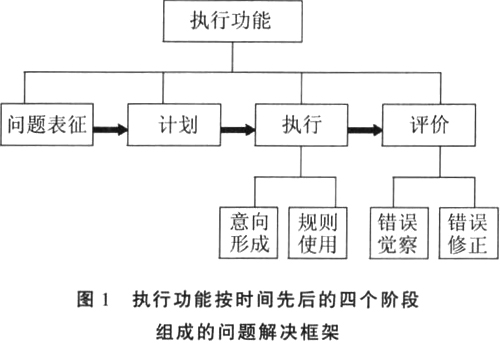首页 -> 2007年第7期
儿童数学认知障碍的执行功能解释
作者:魏勇刚 庞丽娟
2.4 问题解决假说与数学认知障碍
有研究者把执行功能看作是由问题表征、计划、执行和评价四个阶段构成的问题解决过程,其中执行阶段包含意向形成和规则使用两个过程,评价阶段包含错误觉察与错误修正两个过程,如图1所示[10]。

执行功能的问题解决框架理论突出了执行功能的各个加工阶段的共同作用,而不是单一的工作记忆或者抑制控制的结果。把执行功能定义为一个宏观的问题解决框架,说明执行功能所包含的自我调控过程的内在复杂性,从而促使我们深入探讨执行功能各认知加工过程之间的相互作用。对这一框架进行直接证明的就是著名的汉诺塔问题(Tower of Hanoi)[19]。在汉诺塔问题解决过程中,被试利用被告知特定规则,按照一定的计划,有步骤地解决问题。该任务与执行功能的其它任务如搜寻任务、优势规则抑制任务、灵活反应任务等相比,除了工作记忆、抑制控制等认知能力以外,还要求更为高级的利用规则制定计划以控制自己行为的能力、问题表征能力以及认知监控能力。而这些能力,正是数学认知活动所必需的认知成分。如果在数学问题的理解与表征、数学问题解决步骤的计划与执行、以及对数学问题解决过程的监控等方面存在障碍的话,就会造成数学认知的困难。例如,胥兴春和刘电芝[20]的研究表明:数学学习障碍儿童问题解决的表征时间较短、表征类型单一以及表征缺乏有效性。
3 小结
儿童数学认知障碍的执行功能解释/魏勇刚 庞丽娟从执行功能的基本假设来看,无论是认知神经观点、工作记忆观点、抑制控制观点还是问题解决观点,都可以对儿童数学认知障碍进行很好地解释。因此,儿童执行功能的发展机制可以为儿童数学认知障碍的预测与干预提供有效启示。然而,已有的研究也存在着一定缺陷,主要表现为不能从整体上解释执行功能与儿童数学认知障碍的直接关系。从研究设计来看,目前的研究都是分别采用现成的数学认知实验范式和执行功能实验范式对儿童进行测量,然后通过测量结果来求它们之间的相关,最后根据相关的结果来推导它们之间的关系。这种设计虽然可以证明二者之间存在联系,但是难以深层次揭示这种联系的内在机制。未来的研究应该把执行功能与数学认知作为一个整体的实验任务来设计,通过分层控制可以更好地揭示执行功能与数学认知障碍的内在联系。
参考文献
1 郭兆明, 宋宝和, 张庆林. 中国心理学界数学教学心理研究的十年进展. 数学教育学报, 2005, (2): 12-16
2 刘昌. 数学学习困难儿童的认知加工机制研究. 南京师大学报(社会科学版), 2004, (3): 81-88
3 陈英和, 耿柳娜. 数学焦虑研究的认知取向. 心理科学, 2002, (6): 653-655
4 董奇, 张红川, 周新林. 数学认知: 脑与认知科学的研究成果及其教育启示. 北京师范大学学报(社会科学版), 2005, (3): 40-46
5 Zelazo P D, Craik F I M, Booth L. Executive function across the life span. Acta Psychologica, 2004, 115: 167-184
6 王淑珍, 栗洪武. 执行功能子成分与学业成就的关系. 应用心理学, 2006, (2): 187-192
7 Bull R, Johnston R S, Roy J A. Exploring the roles of the visual-spatial sketch pad and central executive in children's arithmetical skills: views from cognition and developmental neuropsychology. Developmental Neuropsychology, 1999, 15: 421-442
8 周世杰, 杨娟, 张拉艳. 工作记忆、执行功能、加工速度与数学障碍儿童推理和心算能力的关系. 中国临床心理学杂志, 2006, (2): 574-577
9 李红, 王乃弋. 论执行功能及其发展研究. 心理科学, 2004, (2): 426-430
10 王乃弋, 李红, 高山. 评执行功能的问题解决理论. 心理科学进展, 2004, (5): 706-713
11 Nieder A, Freedamn D J, Miller E K. Representation of the quantity of visual items in the primate prefrontal cortex. Science, 2002, 297: 1708-1711
12 Sawamura H, Shima K, Tanji J. Numerical representation for action in the parietal cortex of the monkey. Nature, 2002, 415: 918-922
13 Risberg, J., Ingvar, D. H.. Patterns of activation in the grey matter of the dominant hemisphere during memorizing and reasoning:a study of regional cerebral blood flow changes during psychological testing in a group of neurologically normal patients. Brain, 1973, 4: 737-756
14 陈英和, 王明怡. 工作记忆广度对儿童算术认知策略的影响. 心理发展与教育, 2006, (2): 29-35
15 李晓东, 聂尤彦, 庞爱莲等. 工作记忆对小学三年级学生解决比较问题的影响. 心理发展与教育, 2003, (3): 41-45
16 Bull R, Scerif G. Executive functioning as a predictor of children's mathematics ability: inhibitory, switching, and working memory. Developmental Neuropsychology, 2001, 19: 273-393
17 罗琳琳, 周晓林. 执行功能与数量加工: 回顾与展望. 心理科学进展, 2004, (5): 714-722
18 隋光远, 吴燕, 曹晓华. 数困儿童在内源和外源注意条件下数字比较的眼动研究. 心理科学, 2006, (3): 583-587
19 李红, 高山, 王乃弋. 执行功能研究方法评述. 心理科学进展, 2004, (5): 693-705
20 胥兴春, 刘电芝. 数学学习障碍儿童问题解决的表征研究. 心理科学, 2005, (1): 186-188
Executive Function Accounting for Children's Mathematical Cognitive Disability
WEI Yonggang2 PANG Lijuan1
(1. School of Education, Beijing Normal University, Beijing,100875;
2. School of Early Childhood Education, Chongqing Normal University, Chongqing,400043)
Abstract Children's mathematical cognitive disabilities not only involve cognitive components and psychological processes, but also involve cognitive neural mechanism such as prefrontal cortex. Executive Function can forecast and explain children's mathematical cognitive disability from the perspectives of cognitive neural mechanism, working memory, inhibitory control and problem solving.
Key words mathematical cognitive disability Executive Function neural mechanism working memory inhibitory control problem solving
(责任编校:刘玉娟)
[1]